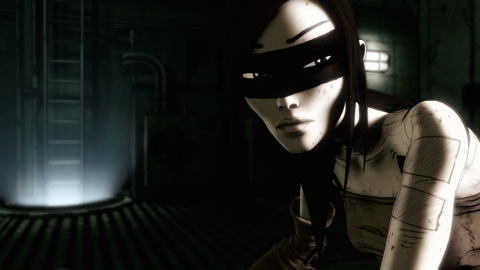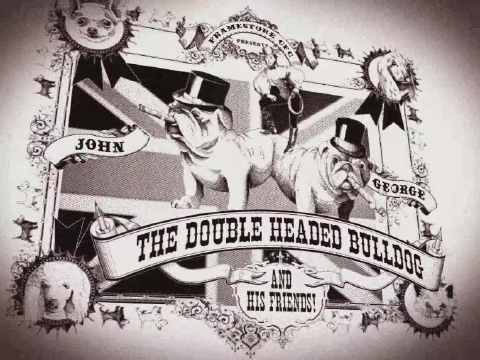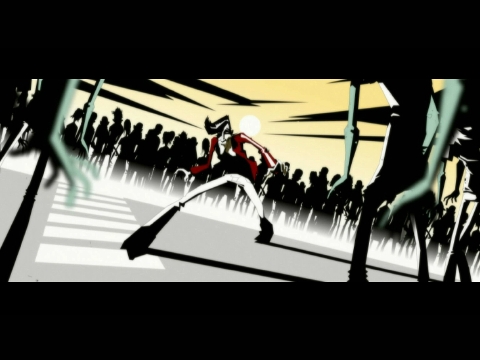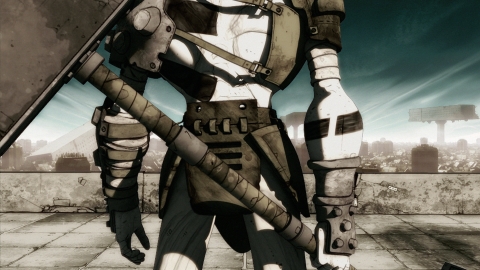Ben Hibon

(1) The Background
In the early/mid 80s, Japanese animation was very cheap to buy for western TV channels, so all the kids programs in Europe were full of animes. I literally grew up watching all the classic Japanese series. I was curious to find out more about them, and that’s when I discovered the source materials for all the animated TV series; the manga books. I’ve always loved western graphic novels, and from a very early age I used to make my own. Over here, graphic novels are very text heavy, with broken strips of still frames that are only there to illustrate the story. In mangas, the unfolding of a story is much more fluid, using the frames as sequences to move the story forward. I think that was a key moment for me, when I started appreciating the differences between comics and mangas. It was the missing link between illustration and animation, which made me want to explore that format. Once I started playing around with animation programs to try to bring my illustrations to life, I unconsciously started to apply the same rules that I made me love Japanese mangas in the first place. Because of its very stylised approach to motions and very dynamic style of editing, the manga techniques allowed me to maximise my visual style and create simple sort films having very limited knowledge of the art of animation (Full Moon Safari or HMS Live Young).
Storyboarding and drawing comic are very similar in many ways; when I storyboard my films I’m actually drawing frames sequences like I used to do in my bedroom when I was a kid. It’s like I’ve going full circle.
I have also worked as an illustrator and a designer ( I was creative director in a design company for four years), and done a lot of photography in the past. Although the road to get to were I am today has not been straight forward, I feel that every art form and every technique that I have learnt along the way has made my work richer and more divers. It has also widen my interests, which I can then filter back into my films and stories. The more I could take in and learn from different fields the more I felt able to adapt and be original in other ones. It now allows me to be part of many aspects of a project, from storyboarding to concepts and designs, from editing to directing.

(2) The Art
I always thought that art was about reaching out; without an audience, musicians, painters or film makers would have no reason to create their work. It’s about communicating an idea, sharing a vision or telling a story. I don’t think that any art form is better than another; it’s about the message, and choosing which media is the most appropriate to deliver it.
In my films I try to tell enjoying and compelling stories. If I direct a TV commercial, a promo or a short, I always try to have a story to drive the film forward. I want to give enough for the viewer to feel something is happening, creating a world around the main protagonists that they will enjoy for 30sec, 2min or 10 min. The difference between pure art and entertainment lies in the creative process. Pure art is free from constraints, and only it’s creator defines its boundaries. Entertainment is a much more commercial process, with many factors to be taken in consideration; market, society, culture, etc… I think that in any creative project, limitations and constraints can be very constructive; it’s about the ability to make the best of what you have at hand, and finding creative and original solutions along the way. Of course I love the art of filmmaking and directing, from a script to a concept, to then a film on the screen. It’s a great process. But I also love drawing and painting, which is simpler more straight forward in the making than animation; it’s something I enjoy doing in my own time, away from commercials ties.

(3) The Direction
I think there are two key elements to good storytelling; the story and the characters. If your script is solid and your protagonists engaging, then the direction style should follow naturally to serve the structure of the film. I always try to include in my films moments of silence and contemplation; i like the concept of slowing down the pace of a scene and looking at it. It’s like having the time to enjoy every aspects of a single frame and capture the stories within. My directorial style is very visual, stylised and illustrative in the framing. I love using simple and strong character poses, mixing sequences of stills, breaking motions in key frames, all of which creates very dynamic framing. I generally work on creating the story from within the shots, not just with camera movements. Storytelling comes from everything, even from the framing itself.
Directing is about telling a story, delivering an experience that will be engaging and immersive enough for an audience to watch from start to finish. And hopefully once the story is told, the viewers can take all these images away and make it their own. A film is like a painting; there’s so much to see, but so much more to be added by the viewer’s own imagination.

(4) Story Telling
The way I think of stories generally starts with an overall concept for a world. Once the universe is defined, I imagine the kind of characters that would live in that world. During the development of the visual concepts for the characters/environments, the different scenes slowly take shape to then create the main plot. Everything is interconnected from the very first concept, and each one of the different aspects of the universe belong together.
Visually, it all needs to work as one. Storytelling is also about immersing the characters and the plots within relevant and compelling environments. Backgrounds elements and secondary characters are as important in telling the story as the main action or heroes. If you have a scene in a bar for example, the very first shot of that place will define in many ways the what/where/how/when of that world, even before any dialogue or action unfolds. That why I always pay a lot of attention and importance to sub-plots, environment and props designs, and all the other details that make up an interesting backdrop for your story.

(5) The animation
What I like so much about animation is the freedom of creativity you can have with the medium! Pretty much anything can be possible; the most crazy visual ideas, scenarios, characters and worlds. If you can draw it you can animate it. It’s very liberating if you compare it to live action, which generally take a lot more production and budget to achieve similar ideas. My films have always been visually very particular, and animation has been the perfect vehicle to produce those ideas. It gives me a level of control (even on a small production level) over the delivery of the creative that no other techniques would allow.
2D and 3D are two different language. They don’t compete because they don’t achieve the same thing. I generally approach them from a storytelling point of view, and choose the medium that will suit that particular story best. It also comes down to your visual treatment, and decide which of the two techniques will translate that style better on the screen. For me, 2D animation allows a great deal of freedom in the visuals. Every key frame is a new drawing, so every position can be re-adjusted to fit the motion/situation. With 3D or live action, you’re set with a CG model or an actor that you then “film” in situation; those parameters are pretty much pre-set to some extend. On the other hand, 3D gives you a lot more “for free”. Take the example of animating a shadow; in 3D it will be pretty much generated by the application, animated and calculated for you throughout the shot. But in 2D, you have to animate the shadow on every single frame by re-drawing it. I always say that 2D animation is a labour of love; it doesn’t give up anything easily, and you have to work really hard at it to make it come to life. But it such a great creative format, and it can be so versatile and original. Directing 3D is much closer to film; you have your cameras, effects, motion capture, etc… I guess for me the big difference between 2D and 3D is how I approach my directing role; with 3D I can focus more on the directing and storytelling, because I worry less on how every key frame is going to look. Once the visual look is locked down, I pretty much know how it’s going to look on screen, which is great. With 2D, I generally find myself simultaneously overlooking the visuals as much as the storytelling. It’s easier to control visually, but more difficult in the production.
They are two totally different experiences, but both are equally rewarding. For me it’s about how you can use the techniques, and you find creative ways to make it look different, make it your own.

(6) The Development
I want to expand my work into longer formats and new techniques, always trying to push it forward. It’s not so much about how/where the content is distributed, which could be cinema, web, TV, phones, etc… but more about the possibility of telling longer and more complex stories. I’m now working on a couple of scripts, which could potentially lead to animated feature film projects or series. I’m also very interested to do more live action projects. But I’m very aware of how complex and costly it would be to shoot some of my animated films, so I’m waiting for the right opportunity to transpose my ideas into live action without having to compromise too much on the originality of the visuals. I have had a lot of interest from producers from the video game and film industry, and it’s been very interesting to see how all these mediums are finally getting closer to working together. I’m always very interested to be working on many different projects; films, video games, series, commercials, promos, and always try to tell good original stories in the process. That’s what it’s all about.

BIOGRAPHY:
Ben Hibon
Ben Hibon was born in Geneva, Switzerland where he completed studies in Fine Art. He moved to London in 1996 to study Graphic Design at the Central Saint Martins College of Art and Design, followed by a Masters Degree at the same school. On graduation he joined a prominent London based design company, where he worked for 4 years as Creative Director. During this time Ben also completed numerous short films, music videos and character design projects, and had his work featured at Onedotzero, Resfest, BAA and the Stockholm Film Festival.
Ben joined Blink in Autumn 2004 and was instrumental in the founding of Blinkink, Blink’s hybrid/animation/CGI division, for which he immediately set about to designing the identity.
He made his commercial debut with a highly successful Kwik Fit campaign for DDB London, a very unconventional mixture of live action performance and graphic 3D animation.
A busy 2005 saw Ben working for MTV Europe and Asia (his action intro sequence for MTV Screen featured in shots issue 90) and he designed characters and animated in-game sequences for Killer7, Capcom’s highly acclaimed video game. Ben also created a sequence for “Tokyo Zombie”, a Japanese horror film written and directed by the infamous Sakichi Sato.
2006 saw Ben’s short film Codehunters premiered at the MTV Asia Awards held in Bangkok, Thailand. His film provided the visual theme for the awards ceremony and its lead-up marketing campaign, with the animation itself being revealed throughout the show. Since it’s release, Codehunters has been shown in more than 30 festivals all around the world, and received nominations at the Raindance Film Festival and the Rushes Shorts Festival. It won a gold award for Best Animation at the Promax/BDA Asia awards in 2006, and took the IMAGINA award and the Golden Nica in 2007 for best short film.
In 2007, SONY Computer Entertainment commissioned Ben to create an animated series for their upcoming Playstation3 flagship title “Heavenly Sword”. The films, released weekly on the Playstation Network, tell the story of Nariko and her clan leading up to the opening scene of the game.
Ben’s work has been recognized by D&AD, Imagina, Promax, British Animation Awards, Creative Circle, Webby, OFFF, Flash Forward Festival/NY and shown at festivals such as Raindance, Rushes Soho Short, onedotzero, Resfest, the Berlin Interfilm Festival, the Edinburg and Stockholm International Film Festivals. His commercial work includes clients such as SONY Playstation, Electronic Arts, MTV Europe, MTV Asia, Sega, Puma, Capcom, Channel4, Namco, Nissan and Kwik Fit.
Ben is currently represented as a commercials/promos director at the production companies “Blink Productions” in the UK and “Furlined” in the US. Colonel Blimp represents for promos in the UK.